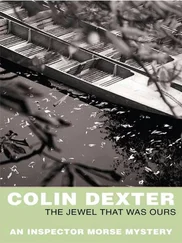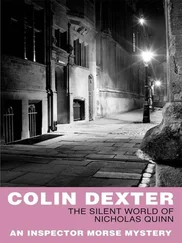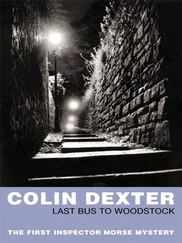‘I don’t understand.’
‘What’s happened, do you think?’
‘No. I wasn’t here, you see.’
‘Of course I will.’
‘Can you just give me the number again?’
‘All right.’
Brenda Brooks put down the phone slowly, her face anxious as she walked back into the lounge — only a few seconds after Lewis, with a silent thumbs-up sign, had re-appeared from the kitchen and quickly resumed his seat.
‘Anything important?’ asked Morse.
‘It was the hospital. Ted’s not been there. Not yet. So the lady at Appointments says. He was due there at twenty-past nine, it seems.’
‘What do you think’s happened to him?’ asked Morse quietly.
‘That’s what she asked me. I don’t know.’
‘I’m sure everything’s fine,’ continued Morse. ‘He’s probably just got the time wrong.’
‘That’s exactly what she said,’ whispered Brenda Brooks.
‘She’ll ring you back — when he gets there.’
‘That’s… that’s exactly…’
But the tears had started now.
She opened her handbag and took out a handkerchief, and said, ‘Sorry’; said ‘Sorry’ five times. And then, ‘Oh dear! Where’s my purse? I must have…’ She got up and went to the hall where she patted the pockets of her summer coat, and came back and looked rather fecklessly around. ‘I must have…’
‘You did some shopping, didn’t you? You may have left it…?’ suggested Lewis.
A few minutes later, Mrs Brooks was seated in the back of the police car, impatient and worried; but so glad to be away from the two detectives — who now stood in her kitchen.
‘What do you reckon, sir?’
‘About Brooks? Buggered off, hasn’t he — sensible chap! He must have guessed we were on his tail.’
‘What about her? She seemed glad to get away.’
‘She’s worried about her purse — money, cards, keys…’
‘More than that, I think.’
‘Well, you made her feel a bit guilty, didn’t you, checking up on her hairdresser — and Stratford.’
‘What?’
‘Quite right too, Lewis. She was telling us a load of lies, wasn’t she? She knows exactly where he is! He may treat her like a skivvy, but she’s still his missus.’
Lewis opened the drawer again, this time selecting four knives, of different sizes, but of the same basic pattern, of the same make — each with a black handle, one side of which, the side of the cutting-edge, was slightly sinuous, with an indented curve at the top to fit the joint of the index finger, and a similar curve at the lower end for the little finger.
Four knives.
Four from a set of five?
But if so, the fifth was missing… yet not really all that far away, neatly docketed and safely stored as it was in an Exhibits Locker at Thames Valley Police HQ.
Oh, yes!
Lewis nodded to himself, and to Morse.
And Morse nodded to himself, and to Lewis.
It seemed to Morse no great surprise that Mr Edward Brooks, ex-scout of Wolsey, and current assistant-custodian of the Pitt Rivers Collection, had decided to make a bolt for it — once news of the discovery of that fatal fifth knife had leaked out.
Which it hadn’t…
Lewis had seen to that.
The museum has retained much of its Victorian character. Painstakingly hand-written labels can still be found attached to some of the artefacts in the crammed black cases there
(The Pitt Rivers Museum, A Souvenir Guide)
The details of what was to prove the key discovery in the case — or, to be more accurate, the ‘lack-of-key’ discovery in the case — were not communicated by the City Police to Kidlington HQ until just after 1 p.m. that same day, although the discovery had in fact been made as early as 8.45 a.m.
Janis Lawrence, an unmarried young woman, lived with her mother, an unmarried middle-aged woman, on the Cutteslowe Estate in North Oxford. The household was completed by Janis’s four-year-old son, Jason — a name chosen not to commemorate the intrepid leader of the Argonauts but the lead guitarist of a long-forgotten pop group. Jason found it impossible to pass by any stone or small brick without picking it up and hurling it at anything which moved across his vision — dogs, prams, pedestrians, motor-vehicles, and similar obstructions. Thus it was that Janis Lawrence was ever longing for the time when she could transfer complete responsibility for the child to the hapless teachers of the local Cutteslowe Primary School. And when she had learned of a temporary (August to September) cleaning job at the Pitt Rivers Museum, she had applied for it. And got it.
The Cutteslowe Estate in North Oxford, built in the 1930s, had achieved national notoriety because of the Cutteslowe Wall, a seven-foot high, spiked-topped, brick-built wall, which segregated the upper-middle-class residents of the Banbury Road from the working-class tenants of the Council Estate. But the wall had been demolished in 1959; and on the bright morning of Thursday, 8 September 1994, as on each weekday for the past month, Janis walked without hindrance up to the Banbury Road, where she caught a bus down to Keble Road, thence walking across to Parks Road, and into the museum itself, where from Mondays to Saturdays she began work at 8.30 a.m.
Her first job as always was to clear up any litter, such as the rings of zig-zag shavings often left behind by pupils who had sharpened their pencils the previous afternoon. And for a short while that morning, as she cleaned the floor and dusted the cabinets in the Upper Gallery, she paid little attention to the bright-yellow splinter of wood on the floor below one of the cabinets there — until she noticed that the glass-topped lid was not resting flush upon its base. Then, too, she became aware of the slight disarray of the cabinet’s contents, since there appeared one unfilled space in the ranks of the exhibits there, with both the artefact to the left of this gap, and the artefact to the right of it, knocked somewhat askew on the light-beige hessian material which formed the backing for the display: ‘Knives from Africa and South-East Asia’.
Janis reported her discovery immediately. And just after 9 a.m. Mr Herbert Godwin, attendant with responsibility for the Upper Gallery, was staring down at Cabinet 52.
‘Oh dear!’
‘Somebody’s pinched somethin’, Bert?’
‘I reckon you could say that again.’
‘What’s gone?’
‘Good question.’
‘When could it have been, though?’
‘Dunno. After I checked last night. Must have been. I allus check on these cabinets.’
‘Well, it couldn’t have been this morning. Nobody else’s been here, ’cept me.’
‘Have you got summat hidden in your knicker-pocket, Janis?’
‘I’ve told you before , Bert. I only wear knickers on a Sunday.’
Gently Herbert Godwin patted the not-unattractive Janis on her ample bottom: ‘We’d better go and inform our superiors, my love.’
Paradoxically Jane Cotterell, Administrator of the Museum, was attending a meeting that morning at the Ashmolean on ‘Museum Security’. But straightway she was summoned to the telephone and was soon issuing her orders: the University Marshal was to be informed immediately, as were the police; the lower steps to the Upper Gallery were to be roped across, with the ‘Temporarily Closed’ sign positioned there; Dr Cooper, the Assistant Curator (Documentation) — and only Dr Cooper — should go along and, without touching anything, seek to ascertain, from his inventory lists, which object(s) had been stolen. She herself would be back in the Pitt Rivers as soon as she could possibly manage it.
Which was three-quarters of an hour later, her return coinciding with the arrival of the police from St Aldate’s; and with the production of a sheet of paper on which she found the following sketch:
Читать дальше












